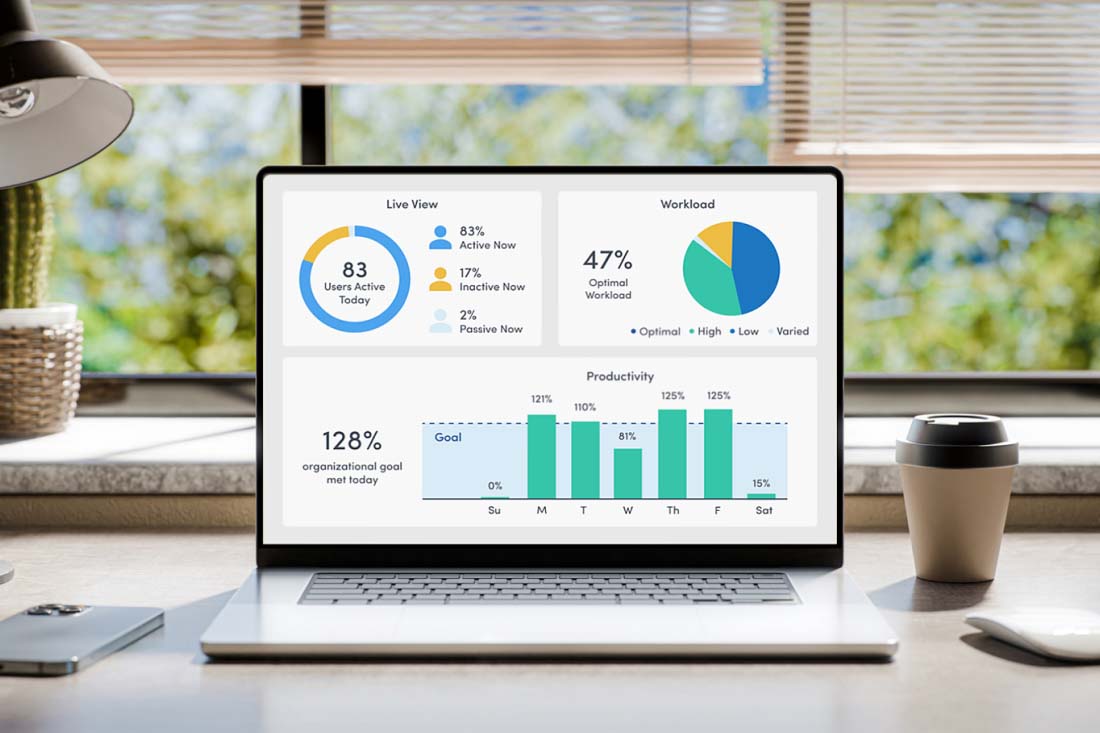As 2022 forges ahead, an increasing number of organizations are implementing workforce analytics strategies as part of a bigger shift towards more data-driven decision-making. In fact, 451 Research has seen a consistent shift in their workforce analytics research year over year. Understanding employee health, productivity, and wellness over the past two years have required more context than ever now as most employees are working remotely or in a home/office hybrid setting.
In the first blog in our Secret to Success series, we explored the three main challenges of remote-hybrid work and how workforce analytics software, when properly implemented, can provide valuable insights to help organizations improve business outcomes and help teams work wiser. When analyzed, this data can provide insights about how work gets done, how teams interact, how employees can learn and improve in their jobs, and how business results can be optimized.
These insights range from:
- What applications employees are using
- How the apps are used
- Who’s using the apps and when
- Are employees improving their skill sets
- Which goals are getting accomplished/which are in progress
Now, we will explore two of the main ways that workforce analytics insights enable better business outcomes and improve the employee and customer experience, no matter where they’re based.
Workforce Analytics Creates Alignment
When a majority of the workforce shifted to a work-from-anywhere program in 2020, leaders and managers alike scrambled (and are still scrambling) to get insights into their teams’ behavior and workflows with their in-office visibility gone. Through this effort, leadership teams are realizing they need a stronger foundation to make decisions on how teams collaborate, operate, and design their workflow.
The insights provided from a workforce analytics program help organizations build a partnership between employers and employees. It allows an entire team to be invested in identifying workflow pain points, understand what activities improve engagement, and create a culture of continuous improvement.
This improved investment is achieved through an increase in operational transparency and an encouragement of open conversation around data-driven insights. When you have data around employee productivity trends, workflow bottlenecks, distractions, and daily activities, managers have all the insights they need to have informed and effective conversations with employees to identify patterns that fuel success and opportunities for improvement.
Additionally, when employees are productive and happy, customers are happy too. There is growing evidence that a positive customer experience – which can increase customer retention rates, add new customers (through positive word of mouth), and ultimately, generate more revenue – is based on a strong employee experience. So, it’s not surprising that organizations are using workforce analytics to nurture the link between positive employee and customer experiences and reap the business success that comes from that union.
But alignment and customer experiences aren’t the only factors that workforce analytics tools can improve.
Workforce Analytics Enables Engagement
According to a recent study by Gallup, only 15% of employees are engaged in the workplace. While that statistic may be shocking, it makes sense that engagement would decline with the shift to remote work. This kind of disruption has had company leaders re-evaluating the resources they need to support employees and make them feel appreciated as remote/hybrid work becomes the norm.
To this end, organizations are using insights from workforce analytics tools to gain visibility of employee activity on an individual level, a team level, and even an organizational level. With access to near-real-time activity data, managers can ensure all employees are engaged through:
- Assessing and optimizing team workload balance.
- Identifying opportunities to prevent burnout.
- Re-engaging underutilized employees.
In addition to these new perspectives offered by workforce analytics tools, managers can detect employee trends and patterns that would normally be easy to miss.
For instance, when managers can view weekly activity to understand what is enabling or hindering productivity and focus, they can start a data-driven conversation with employees who may be in danger of burnout and help them prioritize workload, health, and wellness. Managers can also use time tracking to see when employees are engaged the most and build a schedule around that period of high productivity, helping employees complete projects to the best of their ability.
When employees are continuously engaged with their tasks, team members, and clients, customer relationships will only strengthen and grow. High engagement levels have the potential to stop customers from churning, increase renewed contracts, and result in customers recommending your services to other businesses, all of which can greatly impact the bottom line.
While all these workforce analytics features help improve employee alignment and engagement, organizations are still grappling with challenges as they adjust to remote/hybrid work environments. Part 3 of The Secret to Success blog series will discuss three ways to make sure that your workforce analytics tool is implemented successfully and effectively.
There’s More to Workforce Analytics Than You Think
When it comes to the insights gained from workforce analytics, managers can have the power to completely transform and elevate the way their team operates. Using a workforce analytics tool like ActivTrak allows leaders to focus on contextual data that helps them support employees and, by extension, keep customers satisfied and the overall business thriving.
To learn more about the possibilities of workforce analytics, check out our Manager’s Guide to Productivity Management.
About ActivTrak
ActivTrak’s workforce analytics provide predictive insights that help leaders, managers, and employees build trust, deepen engagement and boost productivity in the modern, hybrid workplace. This work is supported by the ActivTrak Productivity Lab, a global center for ground-breaking research and expertise that leverages data sourced from more than 9,500 customers and over 550,000 users. Based in Austin, Texas, ActivTrak is backed by Sapphire Ventures and Elsewhere Partners and is led by a seasoned team of software industry veterans. To learn more visit: https://activtrak.com/.





